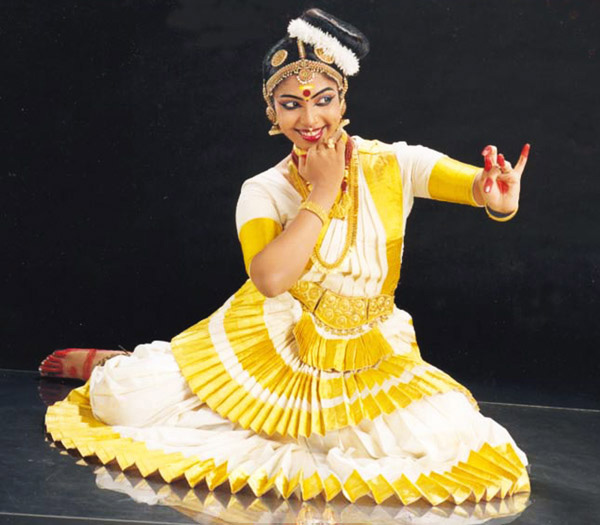Mohiniattam
Introduction: Mohiniattam is the elegant, lyrical classical dance of Kerala, prevailing for centuries and is normally performed by women. The dance movements symbolise the exquisite swaying of the palm trees of Kerala. It is the dance of the enchantress and not the dance of the seductress as misunderstood by many. It is based on the lasya concept of dancing, a feminine, graceful style of dancing, initiated by goddess Parvati.
Another popular story is that of the demon Bhasmasura, an ardent devotee of Lord Shiva. Due to his penance, the Lord granted him the boons that he wanted. Bhasmasura asked for the boon that on whosoever’s head he kept his hand, that person would perish. The boon was granted and the excited demon wanted to try it on Lord Shiva himself. Shiva ran for his life and met Lord Vishnu who told him not to worry. Lord Vishnu appeared to the demon as the beautiful and enchanting Mohini. The demon was completely enchanted by her beauty and proposed marriage. Vishnu agreed on the condition that Bhasmasura dance with her. The demon started to dance with Mohini in great excitement and in the process placed his hand on his own head and perished!
Mohiniattam’s evolution from devadasis: In the temple rituals which prevailed in the 19th century, young teenaged girls were married to the Lord and were known as devadasis or servants of the Lord. They learnt classical music and dance, and performed regularly on social and religious occasions. Four such classical dance styles developed in the devadasi tradition — Bharatanatyam, Mohiniattam, Odissi and Manipuri. Bharatanatyam was known as dasi attam or sadir, Mohiniattam as thevadichi attam, Odissi as maharis and Manipuri dancers were known as meibis. Originally, the devadasis were confined to the temples, but slowly they moved on to dancing to the tune of rich zamindars, chieftains and ultimately at the royal courts of kings. But the dancers did not receive royal patronage or protection to keep their sanctity and classical quality. So these dances began to deteriorate and degrade until social reformers like Mahakavi Vallathol and great poets like Rabindranath Tagore intervened to give these dances a new respectability.
Kerala Kalamandalam: The great poet in Kerala, Mahakavi Vallathol, established Kerala Kalamandalam in 1930 at Cheruthuruthy in central Kerala, to convince people that classical dances are essentially sacred, hence youngsters could learn these dance forms. Kathakali and Mohiniattam were taught in this school of dance in the beginning. The first teacher of Mohiniattam was Kalamandalam Kalyani Kutty Amma, wife of legendary Kathakali artist Kalamandalam Krishnan Nair.This premier centre for performing arts in India has produced several dance professionals and teachers. Kalamandalam Satyabhama, Sugandhi, Nirmala Panikkar and Kalamandalam Kshemavathy are the most senior exponents. Some dancers with religious themes are Gopika Varma of the royal family of Travancore, Shyamala Surendran, Jayaprabha Menon, Ayswaria Warrier, Geeta and Radhika Radhakrishna, Neena Prasad, Pallavi Krishnan, Rachita Ravi and Mythili Anoop.
Dr Kanak Rele’s contributions: Dr Kanak Rele, a non-Malayalee, is the only Mohiniattam dancer to receive the prestigious Padma Bhushan award. After receiving a grant from Ford Foundation, Dr Kanak made a documentary on the three pioneer Mohiniattam exponents, Kalyani Kutty Amma, Chinnamuamma and Kunju Kutty Amma and then evolved her own style with musical support in the traditional Sopanam Sangeetam style composed by Kavalam Narayan Panikkar. Dr Kanak introduced several new choreography styles projecting women empowerment with items like Amba, Draupadi, Kubja and Kalyani based on Tagore’s Chandalika and has given several performances all over the globe. She has written books on Mohiniattam like Bhava Nirupana:Dance Vocabulary etc.
A dance educationist, Dr Kanak established Nalanda Dance Research Centre, known as Nalanda Nritya Kalamahavidyalya, with degrees up to the doctorate level. It has trained several dancers, many of them professionals and teachers like Madhuri Deshmukh, Dimple Nair (Doha, Qatar), Sunanda Nair (USA) and young, brilliant dancers, Saji Nair and Megha Ahire Mohad.
Technique and music: While Mohiniattam is considered as an offshoot of Bharatanatyam and Kathakali, the movements are slow, graceful and lyrical, creating a fine visual appeal. While Kalamandalam follows its own bani (style), Dr Kanak’s style has also become immensely popular. Dr Geeta Radhakrishna has written and illustrated an exclusive book Mohiniattam: Adavus and Mudras which is based on Hasta Lakshana Deepika, Natya Sastra, Abhinaya Darpana, Sangeeta Ratnakara and Bharatarnava. 150 adavus (dance units) and 24 mudras (hand gestures) are portrayed. She has also written Mohiniattam: Dance of the Enchantress and other books.
Costumes: The costumes include plain white or off-white such as ivory or cream coloured sari embroidered with bright golden or gold-laced coloured brocade. The dancer wears a fitted choli (blouse) matching the sari, below which at the waist is a golden belt which tucks in the end of the sari, and highlights the waist. In front of the sari, below the belt is a pleated sheet with concentric bands in gold or saffron colours. The dancer wears simple jewellery and no masks, in contrast to Kathakali, the other major classical dance of Kerala.
Music and instruments: The music of Mohiniattam involves various rhythms. There are numerous compositions for a Mohiniattam repertoire, most of whose lyrics are in Manipravalam, a mixture of Sanskrit, Tamil and Malayalam. The musical instruments usually used are Mridangam or Madhalam, Idakka, flute, Veena and Kuzhitalam. The ragas (melody) are rendered in the sopana (steps) style.
















